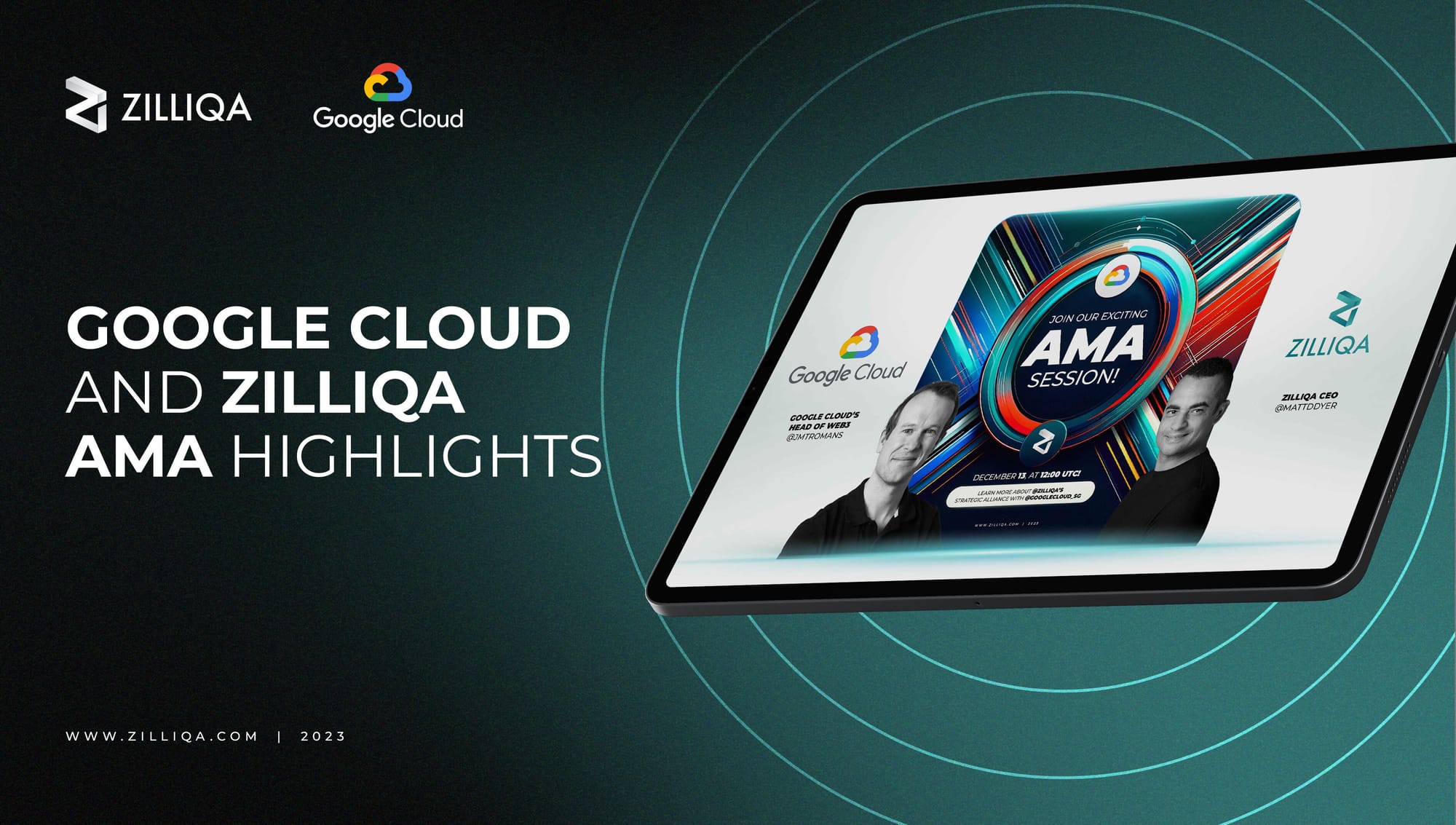AMA Highlights - Zilliqa Group’s strategic alliance with Google Cloud
Check out the highlights from the recent ama with Zilliqa Group CEO Matt Dyer and Google Cloud Head of Web3 James Tromans.

Earlier this year at Token2049 Singapore, Zilliqa Group and Google Cloud announced a multi-year strategic alliance to enhance the data availability and resilience of the Zilliqa network.
The collaboration is a landmark step in the Group’s strategy for expanding its enterprise infrastructure offerings for future partnerships and also encompasses a number of improvements to the elements of the Zilliqa network that it operates.
Google Cloud announced that as part of this alliance, it would operate a Staked Seed Node (SSN) on the Zilliqa network, helping to record a historical archive of transactions and secure transaction correctness on the network.
SSNs are a crucial part of the Zilliqa network, offering a public record of verifiable transactions to users and builders on the blockchain.
Find out more about what SSNs are and the role they play in the Zilliqa network.
Following this announcement, Zilliqa Group CEO Matt Dyer joined Google Cloud Head of Web3 James Tromans for a discussion on the details of this alliance, their views on the future of Web3, and much more.
Check out the highlights from this AMA session below.
Collaborating to drive innovation in the Web3 space
The conversation began with both Matt and James giving their views on the announcement of the strategic alliance, explaining its benefits and framing the multi-year collaboration in the context of wider innovation across the Web3 space.
“Google Cloud has been in and around the Web3 space now for quite a few years. It's our pleasure to be working with Zilliqa now with respect to layer-1 blockchain solutions,” James said.
“Our ability to run a Staked Seed Node is something that is, I think, fairly unusual amongst cloud providers. There are not many other folks that are in a better position to offer these sorts of partnerships and capabilities.”
“I think some of the other benefits that we bring to the relationship from a strategic standpoint is we've been growing a lot in the APAC region and we see a lot of business interest here as well,” he added.
Matt went on to describe the Zilliqa Group’s perspective regarding infrastructure providers and the benefits of working with companies like Google Cloud that are aligned in terms of their Web3 vision.
“We've been looking around from an infrastructure play in terms of who do we partner with, and I think very much from our initial interactions with Google Cloud, it was very much about the hands-on approach and the ability to interface as a team to do the migration from the vendor we're currently using to Google Cloud,” Matt said.
“From our perspective, community is obviously massive in the Web3 space and we felt that the ethos of Google Cloud around understanding Web3 and doing a lot for the space at a moment was a really important point to the relationship.”
“When you look at it from our ecosystem perspective as well, having an infrastructure play that a lot of the ecosystem partners could also leverage is very exciting for us as part of the strategic background,” he said.
Technical impact and matchmaking for Web3 enterprise solutions
Matt noted that the Zilliqa technical team was already benefiting from the transition to Google Cloud, adding that due to the Web3 space requiring reliable infrastructure around the clock, uptime is a crucial component for applications built on the Zilliqa network.
“A major benefit is the lack of impact to the business already operating. Crypto is clearly 24/7 and from our perspective, uptime is a key component.”
“We’ve also got a big vertical play in gaming, and Google Cloud hosted Jump Crypto’s Web3 Gaming Week in Singapore recently. We had one of our sister companies from the gaming vertical as a part of that,” Matt added.
“I think there is a lot of synergy, not just from an infrastructure perspective but also that Zilliqa Group is going to get a lot of value in terms of bringing new businesses to come and work with our blockchain, and equally on the other side, hopefully we can bring Google Cloud new applications or new businesses who want to come in and get set up with Google Cloud.”
Elaborating on this potential to collaborate on growing a Web3 ecosystem, James explained that Google Cloud’s vision for Web3 goes beyond providing infrastructure to connecting companies that build the next generation of Web3 applications.
“Google Cloud has an interesting role to play in this space beyond just network and infrastructure. We obviously have a very large startup and SMB ecosystem that's been growing with us, especially in the Web3 space.”
“But then we also have the traditional financial services businesses, very large enterprises. We've been extremely successful in working with them as well, and yet there is a natural gap there in the sense they're not exclusively in Web3,” James explained.
“When we talk to our enterprise customers, they're often asking about blockchains and how they can learn more and partner with them. We see our role here as beyond that of purely technical - We see it as an opportunity to connect folks, to educate, to bring people together.”
Matt expanded on Google Cloud’s unique position in connecting Web3 startups and enterprise, highlighting how this could be a major growth driver for Zilliqa Group.
“We have got to the stage where we're definitely commercialising what Zilliqa Group is trying to do.”
“Working with some of the organisations you're talking about and building out products on the blockchain - I think that is going to be really beneficial to both parties in terms of moving the industry forward.” Matt said.
Mainstream adoption and the future of Web3
The conversation also focussed on what the Web3 space needs to accomplish to reach mainstream adoption, with both Matt and James stressing the importance of accessibility and streamlining the user experience as crucial to the growth of the technology.
“I think there's a lot of lessons that could be learned from the likes of Google Cloud if we look at the education, the documentation, and the seamless nature of the migration. Blockchain doesn't have that,” Matt said.
“You've got MetaMask, you've got various mechanisms for people to onboard which are really, really challenging. It is very much about coming at it from a UX and UI perspective, understanding the journeys and building applications that deliver that value transfer in a way that makes sense.”
James affirmed this approach, stating that in order for Web3 technology to reach widespread adoption, it would need to be as easily accessible as the web is today.
“I always say if the user has to know they're using Web3, then we have missed it,” he said.
“I think when we see mass adoption, we'll know because we won't be talking about Web2 or Web 2.5 and Web3. We'll just be talking about the web again and the underlying technology, whilst important and critical, won't be the main thing.”
“I do think there's a lot to be learned from Web2. I think we don't just want to forget all of that great innovation and the smart people that helped us get to where we are today. We want to take those lessons forward, learn from the mistakes, and make sure that we don't make them again,” James added.
The conversation concluded with a final question around the future of Web3 from both Zilliqa Group and Google Cloud’s perspectives.
Matt explained that Zilliqa Group’s strategy is to lead the way in the industry by demonstrating scalable, revenue-generating business models built on the blockchain.
“We have got the right partner to enable us to scale or flex or do whatever we need to do as a function of our growth. The space needs to see revenue-generating businesses,” he said.
“Zilliqa Group's vision is becoming a revenue-generating entity so that we can show the market what good looks like. We've got case studies that prove there is revenue to be made in the space because at the moment nobody is doing that.”
Speaking more generally about the future of the Web3 space, James noted that the concept of digital identity would be critical to the success of the industry.
“A successful future will see clarity on how we're going to manage digital identity at scale, and these will be foundational building blocks, aside from purely just the role of technology, that will help us get to solving these business problems and real value creation.”
If you want to hear the full conversation between James Tromans and Matt Dyer, check out the full AMA session.
